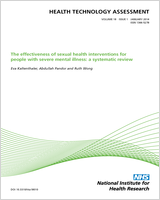NCBI Bookshelf. A service of the National Library of Medicine, National Institutes of Health.
Peters MJ, Khan I, Woolfall K, et al. Different temperature thresholds for antipyretic intervention in critically ill children with fever due to infection: the FEVER feasibility RCT. Southampton (UK): NIHR Journals Library; 2019 Feb. (Health Technology Assessment, No. 23.5.)

Different temperature thresholds for antipyretic intervention in critically ill children with fever due to infection: the FEVER feasibility RCT.
Show detailsEvidence in adults suggests that a high temperature (fever) could help recovery from infection. It is not known whether or not this applies to children in paediatric intensive care units (PICUs). Doctors and nurses (clinicians) usually cool children with fever. Before carrying out a trial to find whether or not cooling children at a higher temperature in PICU works, the FEVER feasibility study was conducted to answer the question ‘can this trial be done?’.
Interviews and focus groups were held with parents and clinicians to find out their views. Twenty-five parents were interviewed and supported the study and the use of research without prior consent. Some were concerned about letting the temperature rise too high if a child was in pain or discomfort. Parents were asked about what outcomes are important. These were (1) long-term morbidity, (2) looking and behaving more normally, (3) length of time on breathing support, (4) time in a PICU and hospital and (5) how quickly vital statistics are back to normal.
To find out how many children might take part in a large trial, information was collected on children with infection from 22 PICUs. This showed that each PICU should see > 10 patients per month.
Finally, a pilot study was run to test if children could be recruited, to see if clinicians followed procedures and to interview people for feedback. Four hospitals recruited 100 participants. Children were randomly allocated to start cooling either at 37.5 °C or at 39.5 °C. Recruitment was higher than expected. There was concern among the children who experienced pain or discomfort. This led to parents declining consent more often in the 39.5 °C group than in the 37.5 °C group and cooling being started earlier than prescribed.
If the large trial focuses only on children receiving invasive ventilation (as these children will receive other medications for their discomfort), the FEVER trial is deemed feasible.
- Plain English summary - Different temperature thresholds for antipyretic interve...Plain English summary - Different temperature thresholds for antipyretic intervention in critically ill children with fever due to infection: the FEVER feasibility RCT
- References - OPTIMA prelim: a randomised feasibility study of personalised care ...References - OPTIMA prelim: a randomised feasibility study of personalised care in the treatment of women with early breast cancer
- Summary of current diabetes health economic models - Optimal strategies for iden...Summary of current diabetes health economic models - Optimal strategies for identifying kidney disease in diabetes: properties of screening tests, progression of renal dysfunction and impact of treatment – systematic review and modelling of progression and cost-effectiveness
- Number of participants recruited at each site - Prognostic models of survival in...Number of participants recruited at each site - Prognostic models of survival in patients with advanced incurable cancer: the PiPS2 observational study
- Scientific summary - Optimal strategies for identifying kidney disease in diabet...Scientific summary - Optimal strategies for identifying kidney disease in diabetes: properties of screening tests, progression of renal dysfunction and impact of treatment – systematic review and modelling of progression and cost-effectiveness
Your browsing activity is empty.
Activity recording is turned off.
See more...